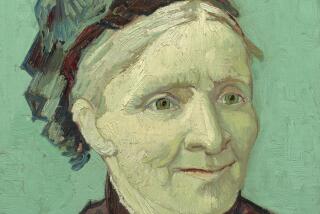The Fine Art of Healing : Artists at Childrens Hospital help young patients unleash creativity on computer screens, canvas and paper. In the process, the patients’ confidence and self-esteem grow.
- Share via
Soon after starting as a staff artist at Childrens Hospital Los Angeles, muralist Barbara Carrasco was so disturbed by what she saw that she nearly quit.
“A nurse handed me a little boy with no arms and legs to hold,” she said. “I wasn’t emotionally ready for that.”
For Gary Glassman, the hospital’s video and media artist, there’s worse. “You have to deal with the kids who die. A little boy I worked with got his last wish--an Amiga computer.”
Said poet Richard Garcia: “The fact that they’re hooked to tubes with something coming out of their stomachs, I don’t look at that. I look at the kid.”
Carrasco, Glassman and Garcia are part of an innovative program at the hospital. With the help of a $320,000 grant from the Mark Taper Foundation in 1991, the Mid-City hospital hires professional artists to work with children whose illnesses range from tonsillitis to cancer.
*
The artists encourage the children to develop their talents by introducing them to great works of art and helping them unleash creativity and individualism on computer screens, canvas and paper. In the process, the patients’ confidence and self-esteem grow, said Margie Wagner, one of the program’s founders.
The benefits of the program are many, yet hard to quantify, administrators and artists say. “(The children) remember the art rather than the medical procedure,” Glassman said. “You can alter their perception of the future and what they can do.”
One of his students, Omar, who suffers from cystic fibrosis, was so enthralled with video that Glassman urged him to apply to a summer program at USC’s film school. The teen-ager was accepted but had reservations about his ability to succeed. “I told him to try his best every day. If he relapsed, we’d deal with it when it came up,” Glassman said.
Omar needn’t have worried. “The feedback I got on him was that he was one of their most exceptional students,” Glassman said. “He really had something to say.”
Omar returns to the hospital often for treatment, Glassman said, and the two continue to work on video projects.
*
“The art gives them the ability of transferring themselves to other aspects of their lives,” Glassman said. “They can get off the victim-thing and become a partner in something else.”
Because artist-in-residence programs are rare in hospitals, it is difficult to quantify their success. There are three or four such programs in the country, and Childrens’ is the only one in the West, according to Jerriann Wilson, of Johns Hopkins Children Center in Baltimore and past president of the Assn. for the Care of Children’s Health. “Children in a hospital feel powerless. Giving them outlets for expression is important,” Wilson said. “As children feel better about themselves, it has a positive impact on their healing.”
The artists are very visible. Carrasco and Glassman are often seen in the halls pushing refrigerator-size carts piled high with video equipment and art supplies. Garcia is less conspicuous with his box of paper, pencils and books. The three wear badges identifying them as the hospital’s staff artists, prompting people to “stop me on the elevator and in the halls and say ‘Boy, you must have the best job in the hospital,’ ” Carrasco said.
But outsiders unaccustomed to dealing with terminally ill children might disagree.
*
A teen-ager, skeletal in oversize clothes that fit him only a few months earlier, walks by with his mother as Glassman shows another youth, his bald head peeking out from a Dodger cap, how to videotape interviews for a history project. As the boy tapes interviews with hospital staffers, the screams of a child undergoing a spinal tap fill the halls.
Meanwhile, in a playroom for younger children, Carrasco paints with six girls seated around a kid-size work table. The girls alternate between giggles and intense concentration. Tall, spindly chrome stands hold IV bags and plastic tubing is connected to their thin wrists.
They paint familiar, childlike scenes: houses, trees, flowers, family. “Mine’s a rainbow at night,” says Jennifer, 7. Lost in the painting, she begins to talk about her upcoming surgery. Occasionally the patients start opening up about intense emotional problems, and Carrasco usually brings in a counselor. “Sometimes it goes beyond what I can handle,” she said.
Poet Garcia remembers recently working with a terminally ill teen-ager in her room. “Workers were there fixing something; she was arguing with her mother, pressing the button for more pain medication, and the nurse wasn’t coming. Meanwhile, we were writing a poem,” Garcia said. “I asked her if she wanted me to leave, but she insisted on finishing. These kids can be in physical pain, with fevers, really hurting, and they keep going, they want to keep writing.”
The patients come from various ethnic groups and income levels. Participation in the program, which serves about 4,500 youngsters a year, is voluntary. In addition to the regular artists, guests from local art institutions conduct workshops and give performances of music, dance and theater. Two professional actors, Joe Walsh and Cindy Friedl, volunteer every week to work with the teen-agers.
The future of the program is uncertain. Ray Reisler, executive director of the Taper Foundation, said officials there hope the hospital “will be able to encourage other foundations and donors to see the beauty that exists in this program and keep it going.”
Program administrators are looking for new funding, including merchandising patient art by putting it on T-shirts, calendars, greeting cards and coffee mugs.
More to Read
Sign up for Essential California
The most important California stories and recommendations in your inbox every morning.
You may occasionally receive promotional content from the Los Angeles Times.










